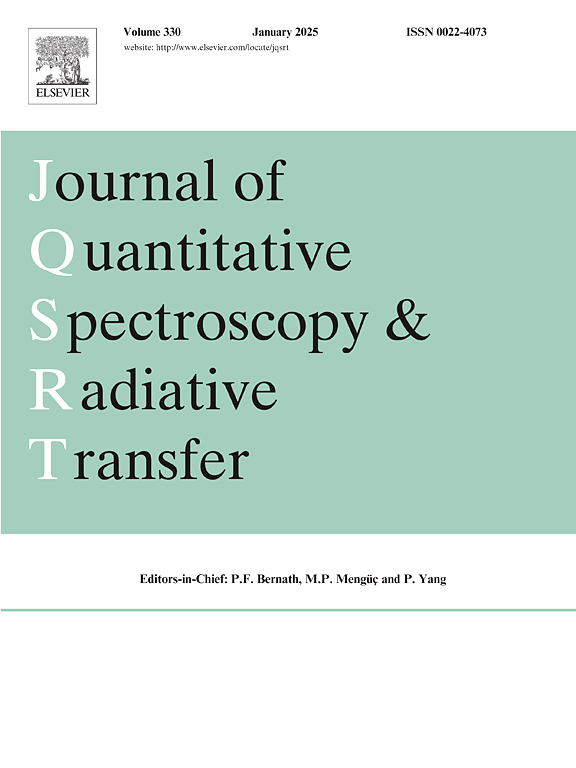Measurement of high-temperature absorption cross-sections using an optical cell with a non-uniform temperature distribution
IF 2.3
3区 物理与天体物理
Q2 OPTICS
Journal of Quantitative Spectroscopy & Radiative Transfer
Pub Date : 2024-10-31
DOI:10.1016/j.jqsrt.2024.109243
引用次数: 0
Abstract
A mathematical method to enable absorption cross-section measurements using an optical cell with a non-uniform temperature distribution is formulated, validated and experimentally demonstrated in this study. The motivation of the proposed method is to facilitate high-temperature spectroscopic studies in the long-wavelength mid-IR region, and to offer an alternative to highly engineered optical cells. The method is based on virtual segmentation of the non-uniform temperature field within an optical cell into bins, each having a sufficiently uniform temperature. By collecting a set of absorbance measurements corresponding to unique temperature profiles and expressing the temperature dependence of the absorption cross-section in terms of a model with limited number of unknowns, a closed-form system of equations is obtained which can be solved to evaluate absorption cross-sections. It is shown, through a set of simulated validation cases, that modeling the temperature dependence in terms of a third order polynomial results in accurate reconstruction of the cross-section spectra for a wide range of cases. Piece-wise polynomials and an alternative nonlinear model are proposed for improved accuracy and to model potentially complex temperature dependencies of the absorption cross-sections. To demonstrate the application of the proposed method, an optical cell with a non-uniform temperature profile was used to measure the cross-section spectra of methane over 1280 – 1330 cm-1 at temperatures up to 523 K. The proposed method is expected to be highly useful in collecting spectroscopic data at high temperatures particularly in the mid-infrared region.
利用温度分布不均匀的光学池测量高温吸收截面
本研究提出了一种数学方法,可利用温度分布不均匀的光学池测量吸收截面,该方法经过验证和实验演示。提出该方法的动机是促进长波长中红外区域的高温光谱研究,并为高度工程化的光学池提供一种替代方法。该方法的基础是将光学池内的非均匀温度场虚拟分割成不同的区块,每个区块都有足够均匀的温度。通过收集一组与独特温度曲线相对应的吸光度测量值,并用一个未知数数量有限的模型来表示吸收截面的温度依赖性,就可以得到一个闭式方程组,通过求解该方程组就可以评估吸收截面。通过一组模拟验证案例表明,用三次多项式来表示温度依赖性模型,可以在多种情况下准确地重建横截面光谱。为了提高精确度,并对吸收截面潜在的复杂温度依赖性进行建模,提出了分段多项式和另一种非线性模型。为了演示所提方法的应用,我们使用了一个具有非均匀温度曲线的光学池来测量温度高达 523 K 的甲烷在 1280 - 1330 cm-1 范围内的横截面光谱。
本文章由计算机程序翻译,如有差异,请以英文原文为准。
求助全文
约1分钟内获得全文
求助全文
来源期刊
CiteScore
5.30
自引率
21.70%
发文量
273
审稿时长
58 days
期刊介绍:
Papers with the following subject areas are suitable for publication in the Journal of Quantitative Spectroscopy and Radiative Transfer:
- Theoretical and experimental aspects of the spectra of atoms, molecules, ions, and plasmas.
- Spectral lineshape studies including models and computational algorithms.
- Atmospheric spectroscopy.
- Theoretical and experimental aspects of light scattering.
- Application of light scattering in particle characterization and remote sensing.
- Application of light scattering in biological sciences and medicine.
- Radiative transfer in absorbing, emitting, and scattering media.
- Radiative transfer in stochastic media.

 求助内容:
求助内容: 应助结果提醒方式:
应助结果提醒方式:


